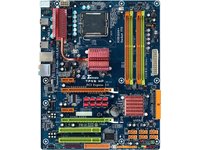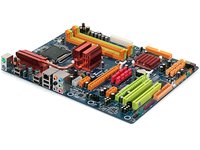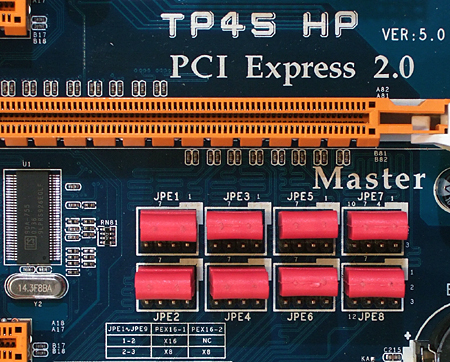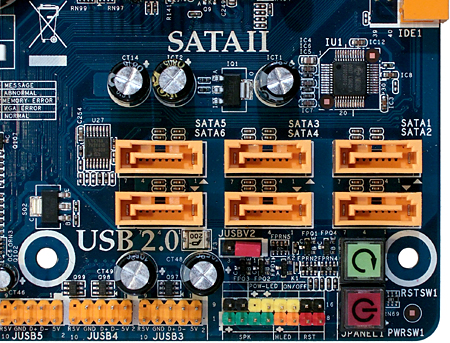11-Way P45 Motherboard Shootout
Biostar TSeries TP45 HP
Biostar’s formula for a successful budget-performance motherboard is a little different than everyone else’s. The best motherboard from today’s comparison to pit against the Biostar TP45 HP is the ASRock P45R2000-WiFi. For a Web price of around $130, buyers can benefit from a simple VRM cooler, but lose the IEEE-1394 controller, WiFi, and dual-compatibility memory slots.
The layout is also better, beginning with the two PCI Express 2.0 slots being separated by three spaces, rather than two, to support super-sized graphics coolers. Biostar also leaves the position beneath the primary x16 slot empty, since the double-thick coolers of performance cards would block any slot off anyway.


Like all dual-graphics P45 motherboards the TP45 HP can connect all sixteen of its PCI Express 2.0 pathways to the primary x16 slot, or divide them across two slots. Electronic switching isn’t available on a motherboard this inexpensive, and unlike ASRock’s competing part the TP45 HP doesn’t even use a simple paddle card. Instead, builder are expected to move eight jumper blocks from the upper to the lower positing to enable the lower slot’s eight pathways. The method isn’t exactly user-friendly, but could make the TP45 HP a friend of experimenters due to its potential ability to test multiple transfer modes (such as x2 and x4) on the second slot.
Biostar hits the target with power cable placement, putting the 8-pin and 24-pin ATX/EPS connections on the top and upper front edge, but once again the 8-pin latch is on the wrong side. Systems with power supplies under the motherboard’s bottom edge will cause builders some grief, as pulling a cable up behind a motherboard tray and around the top edge of the TP45 HP will result in the 8-pin connector’s latch being covered by the cable. This is also true of the two Asus motherboards we just examined, and our best advice to anyone who isn’t interested in such challenges is to use a case with the power supply at the top.
The Ultra ATA cable header is far enough up the TP45 HP’s front edge to ease stretching a cable to the top bay of many mid-towers, but taller cases will require a longer-than-standard cable. It’s good that most builders have ditched the ancient standard, because our attempts to use the Ultra ATA connector with a boot drive failed !
Serial ATA connections are an even bigger problem, as the top row is completely covered by the ’sinks of long double-slot cards. This won’t be an issue for HD 4850 users, but anyone planning to enable CrossfireX using two HD 4870 X2’s should look for a different motherboard. The single-GPU HD 4870 covers only one of the six ports completely.
Not that we want to over-criticize TP45 HP port placement, as the traditional outward-facing connectors make it easy to put the motherboard into any case that supports the full sized ATX form factor. Compare this to the forward-facing ports Asus provides, and see how a hard drive cage often blocks off the ports of the much more expensive competitor. On the other hand, ASRock’s SATA ports have neither issue, and Biostar is in a similar market.
Get Tom's Hardware's best news and in-depth reviews, straight to your inbox.
Three USB 2.0 headers (six ports) make it easy to install up to six front panel ports and devices, while power and reset buttons beside them ease bench testing.
As with the competing P45R2000-WiFi, the Biostar TP45 HP puts its floppy connector under the lowest PCI slot making cable management a nightmare for Windows XP users who need the drive for loading AHCI or RAID drivers. Worse still is the front panel audio header, with a rear-bottom-corner location that’s sometimes impossible to reach for the cables of front-panel connectors. The FP Audio header location is common to most manufacturers, but if everyone did it, it would still be wrong.
Many companies have retained the serial port header, but Biostar went further by also keeping the parallel printer port. These use standard break-out cables if you can still find them, and the difficult-to-reach location is actually perfect for any break-out plate mounted in a case’s bottom card hole.
Current page: Biostar TSeries TP45 HP
Prev Page P5Q Deluxe Software And Accessories Next Page TP45 HP Onboard Devices-
nickchalk Where are the lower price P45 M/B ?Reply
Asus P5Q pro is out for €110 and P5Q deluxe for €165 the price difference is about 70$ in Greece. -
Proximon I suppose I can get some good from having read this. Did you get paid by the word? Maybe next time you could just put together a complete features chart so that we can have some convenient comparison? You know, so someone could go to a chart and see at a glance which boards had eSATA or firewire, or 8 USB.Reply
-
JPForums I'd rather have the overabundance of information than a lack of information. Presentation could use a little refining (I.E. comparison charts and the likes), but having the relevant information available at least is a good thing.Reply -
the introduction and specifics are nice, the comparision isn't. so, why don't you test with an 8500 or qx9650? 6850 are outdated... and a mobo handling a c2d doesn't mean it can handle a quad too, see P5K for example (it stinks when it comes to a q6600).Reply
-
Crashman procithe introduction and specifics are nice, the comparision isn't. so, why don't you test with an 8500 or qx9650? 6850 are outdated... and a mobo handling a c2d doesn't mean it can handle a quad too, see P5K for example (it stinks when it comes to a q6600).Reply
Tom's Hardware wants the performance of current articles to reflect that of recent articles, so a "standard test platform" was chosen a while ago. It will get updated, but probably not before the new socket becomes widely available. -
zenmaster I would have liked to see something such as a P35 and an X48 as controls to help analyze the P45 Performance.Reply
In otherwords, What is the P45 Gaining me over the older P35.
What would I gain by going to the X48. (Or Lose) -
Crashman zenmasterI would have liked to see something such as a P35 and an X48 as controls to help analyze the P45 Performance.In otherwords, What is the P45 Gaining me over the older P35.What would I gain by going to the X48. (Or Lose)http://www.tomshardware.com/reviews/intel-p45-chipset,1961.htmlReply -
johnbilicki The first 17 pages were filled with nothing but junk from ASUS. Do us a favor: don't even bother featuring or *MENTIONING* anything for any reason from a company that refuses to RMA 200-400 dollar brand new motherboards with anything other then used and usually broken junk. It destroyed my enthusiasm for the article.Reply -
dobby nickchalkWhere are the lower price P45 M/B ?Asus P5Q pro is out for €110 and P5Q deluxe for €165 the price difference is about 70$ in Greece.Reply
the p5q PRo is a p43 board, i should know i have one



